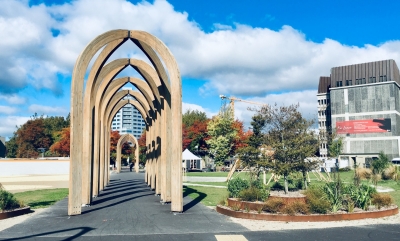This public seminar, held on the 12 April 2019, at Auckland City Council, convened interested scholars from the University of Auckland and interested research-user audiences from the Auckland City Council network and city centre groups. This event discussed the critical roles that public art have played, or may play, in establishing socially inclusive space in a post-disaster urban context.
Dr Martin Zebracki was an invited guest convener from the University of Leeds, UK and, together with Professor Peter O’Connor from the Faculty of Education and Social Work from the University of Auckland, provided a presentation about the inclusive potentials and limitations of public and community art in urban environments that are distressed by traumatic events.
The empirical focus of the event was on the post-disaster urban landscape of Christchurch, following the 2010–11 Canterbury earthquakes. Since then this city has witnessed a unique, burgeoning phenomenon of publicly commissioned art and grassroots community art initiatives. O’Connor drew first-hand examples from this city as well as from other recent urban post-earthquake contexts in China and Mexico.
Zebracki presented findings from observational and interview-based fieldwork conducted in Christchurch in 2018, as part of CARED: Community Art & Recovery in Environments Disrupted by Disasters. This is a research mobility project funded by the University of Leeds, in partnership with Dr David Conradson, Associate Professor of Human Geography at the Department of Geography, University of Canterbury, Christchurch, and in further collaboration with local planners, policymakers and arts and community groups.
Zebracki discussed the extent to which public and community art projects have articulated and established space for social difference and members of often less powerful social groups, including gender and sexual minorities, ethnic minorities, children, the elderly, people with disabilities, migrants and refugees.
The subsequent focus group led by Zebracki set an interactive debate with the participants about the possibilities and limitations for public and community art projects to contribute to a more just and socially inclusive city. It aimed to pool expertise and exchange insights to establish a space for co-learning across academic, policy, and arts agendas.
Please contact the conveners if you would like to learn more about this event and their research projects.
Martin Zebracki is Associate Professor of Human Geography at the University of Leeds. He has published widely at the crossroads of public art practice, sexuality, citizenship, digital culture, and social inclusivity. He is the joint author of The Everyday Practice of Public Art: Art, Space, and Social Inclusion (Routledge, 2016) and Public Art Encounters: Art, Space and Identity (Routledge, 2017) and is an Editorial Board Member of Public Art Dialogue. Zebracki is the Principal Investigator of the multi-site research project Queer Memorials: International Comparative Perspectives on Sexual Diversity and Social Inclusivity, supported by an award from the UK Arts and Humanities Research Council (AHRC).
Peter O’Connor is Professor of Education and Director of the Creative Thinking Project at the University of Auckland. O’Connor is an internationally recognised expert in applied theatre and drama education. His research focuses on applied theatre in marginalised and vulnerable communities. He has created and researched theatre in earthquake zones in China, Christchurch and Mexico City. He is particularly interested in the relationship between the arts, disaster capitalism and democracy. He considers the possibility for the arts to perform counter narratives as well as providing space for unifying community response. O’Connor is particularly interested in the relationship between beauty and earthquakes.







